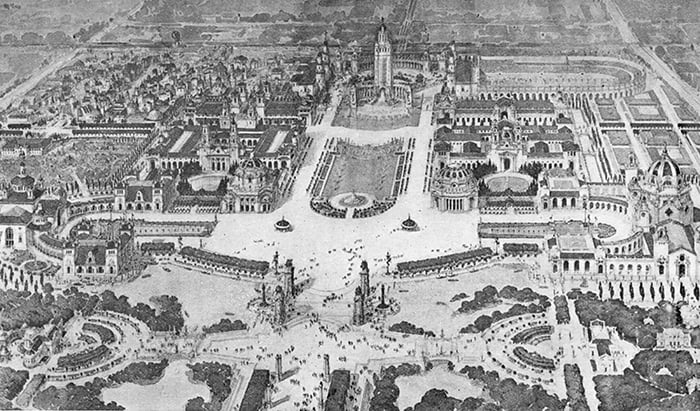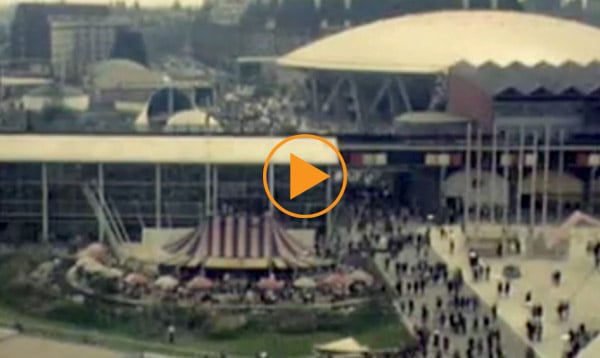
All the World on Show: The Universal Exhibition
As someone who buys more books than he will ever have time to read and as someone who shares his home with a librarian, I am used to being surrounded by large piles of methodically organised books. Nothing, however, could have ever prepared me for my first visit to the Frankfurt Book Fair twelve years ago and the seemingly endless halls filled with shelf after shelf of the world’s newest publications. This year I’ll be packing my most comfortable shoes and a box of business cards to represent Bridgeman Images for the first time.
Although the Frankfurt Book Fair traces its history back some five hundred years to the invention of movable type, the modern day Book Fair, both in its size and the enormous stands some of the publishers build in the halls, always reminds me much more of the twentieth-century heyday of international and pan-American expositions rather than the bazaar that Gutenberg and his immediate successors would have recognised.
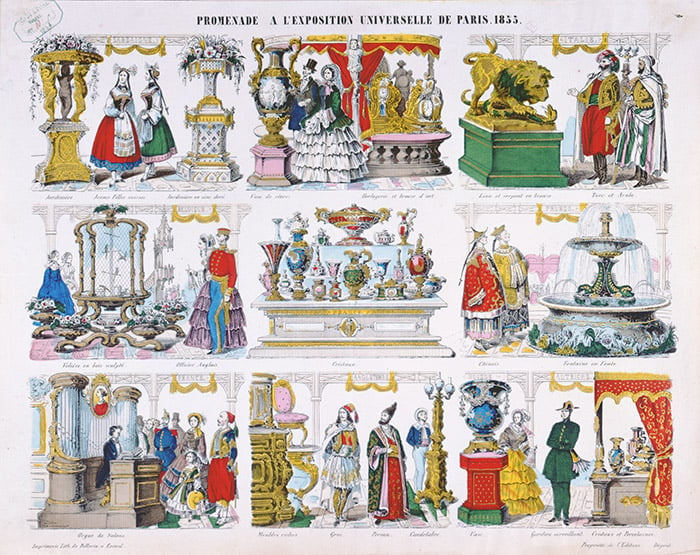
Visitors to the Exposition Universelle in 1855 (coloured engraving)
Visitors to the Exposition Universelle in 1855 (coloured engraving), French School, (19th century) / Musee de la Ville de Paris, Musee Carnavalet, Paris, France / Archives Charmet / Bridgeman Images
Inspired by the national expositions popular in France in the 1800s, the first world fairs concentrated squarely on the industrial progress of individual nations. For all its grandeur and royal patronage, the 1851 Great Exhibition in Crystal Palace was still the place to come to see the latest advances in tractor design:
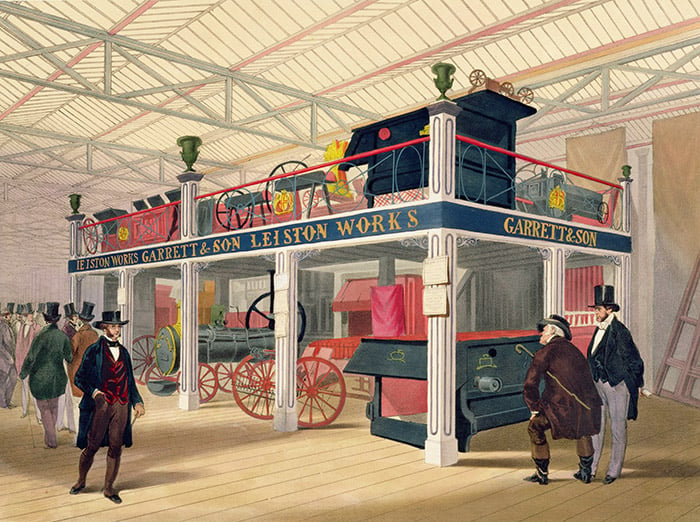
Crystal Palace, the Agricultural Court (coloured litho)
Crystal Palace, the Agricultural Court, coloured lithograph by C.T. Dolby (fl.1851) / The Stapleton Collection
These first exhibitions stressed technological innovation: the telephone, the x ray and the diesel engine all premièred at world fairs. There’s a fascinating piece of archive in the Bridgeman Footage collection showing visitors to the Exposition Universelle of 1900 trying out the new Métro system, complete with a tantalising glimpse of the giant Ferris wheel erected for the fair, the first of its kind anywhere in the world.
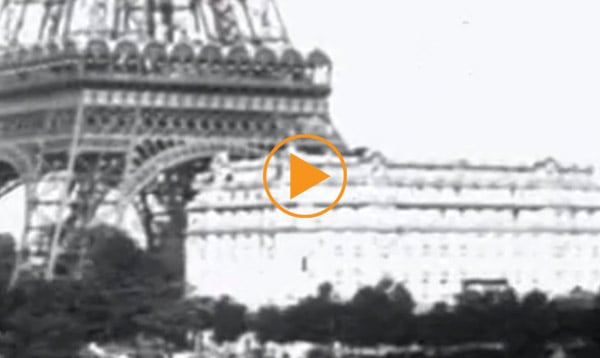
Paris World Fair of 1900 (possibly). Paris metro, landmarks and people at the turn of the century / Film Images
However, countries soon realised that the world fairs gave them the opportunity to promote more than just their national scientific progress. Nations began to see the fairs as a chance to assert their identity to the world and engage in what today we might see as branding. If you’re looking for one image to sum up the political tension in Europe in the late 1930s, I can think of few more striking than this postcard from the 1937 Paris expo:
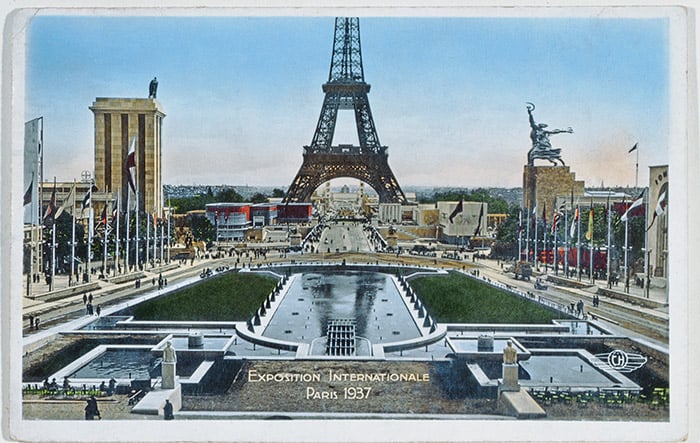
Postcard of the International Exposition with the Eiffel Tower and the German and Soviet Pavilions, 1937 (colour litho), French School, (20th century) / Private Collection / Archives Charmet
On the right-hand side, Stalin’s Soviet Pavilion, with its colossal sculptures of muscular comrades brandishing hammer and sickle faces off across the Champs de Mars against Hitler’s German Pavilion designed by Albert Speer. The other pavilions, even the Eiffel Tower itself, seem dwarfed by these two European dictatorships; not coincidentally Picasso’s Guernica was on show in the Spanish Pavilion that year.
After the Second World War, the tone of the world expos shifted to one of cultural exchange and progress. Although not strictly speaking a world fair, the 1951 Festival of Britain was inspired by the Great Exhibition a century before and illustrates this change in attitude very well, as the British people attempted to put the horrors of war behind them and look forward to the new and the beautiful:
What I love about this footage from the North West Film Archive are the flashes of colour even during rationing: the sunshine yellow coat the woman is wearing at the start, the fireworks at the end, and the bright colours of the temporary buildings constructed for the Festival. There’s a real sense of optimism on the faces in the crowds.
So much of what was built for the world fairs, much like the stands at the Frankfurt Book Fair, is transient: most of the pavilions are destroyed or re-purposed, or burn down, like the original Crystal Palace. Some, like Mies van der Rohe’s 1929 Barcelona Pavilion, are saved and transplanted away from their original context, becoming art installations and historic monuments. The Royal Festival Hall in London survived the 1951 Festival and was the first post-1945 building to be granted Grade I listed status, whilst the Skylon, the atomic needle that is an iconic symbol of the Festival of Britain, was pulled down and used for scrap. The Eiffel Tower still draws tourists to the heart of Paris, many of whom unaware that it was built for the 1899 World’s Fair and was originally only planned to last for twenty years.

Views of the construction of the Eiffel Tower, Paris, 12th February and 12th March 1889; Musee de la Ville de Paris, Musee Carnavalet, Paris, France
Meet me at the Frankfurt Bookfair
Although the Messe Frankfurt, all 578,000 square metres of it, may not be as immediately recognisable to tourists, the exhibition halls are well known to publishers around the world.
I’ll be visiting the Fair this year so if you are visiting do stop by Bridgeman Images, if only to give yourself an opportunity to rest your feet!
If you can’t make it, here’s a selection of images from various expositions and fairs around the world for you to enjoy from the comfort of your own chair.
Save
Save
Save
Save
Save

